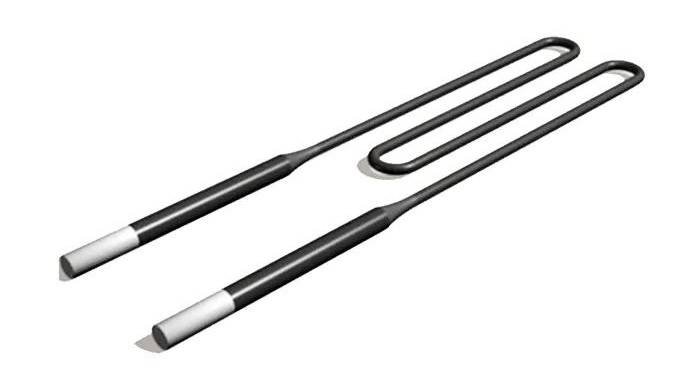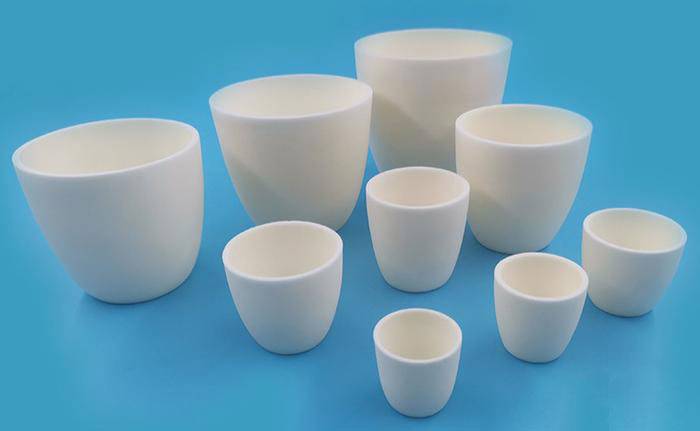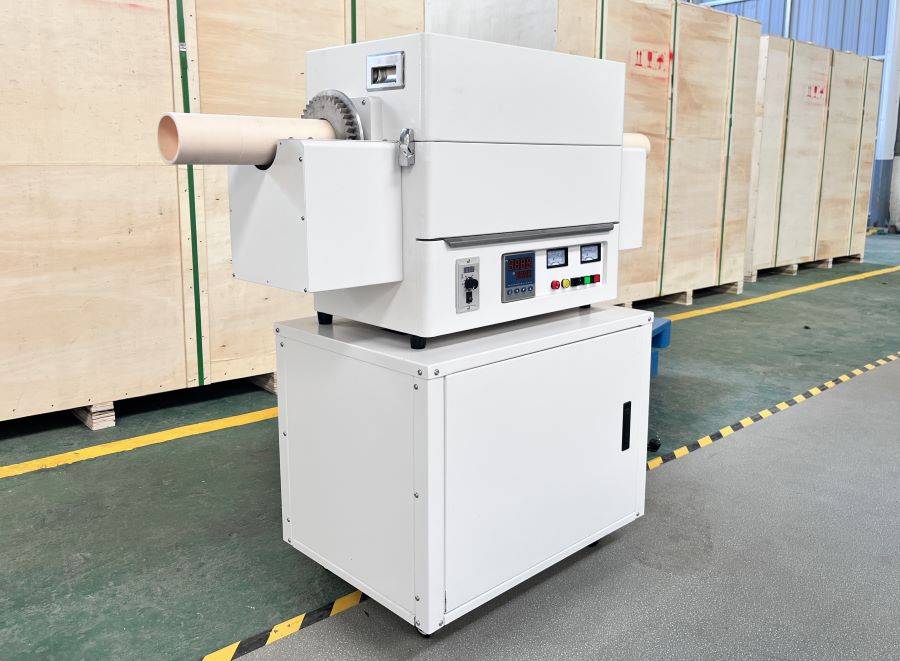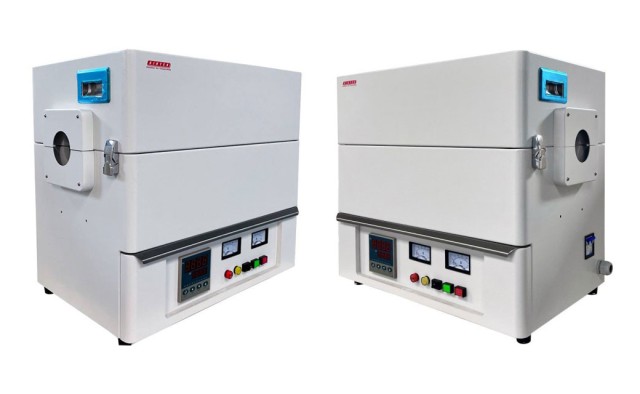温度注意事项
最高和连续工作温度
在为实验室实验选择管式炉时,确保温度范围与最高温度要求精确一致至关重要。这不仅包括确定管式炉可达到的最高温度,还包括了解管式炉长时间持续保持该温度的能力。
关键温度指标
- 最高温度:这是窑炉所能达到的温度范围的上限。选择最高温度超过实验所需峰值温度的窑炉至关重要。
- 连续工作温度:这是指窑炉可以长时间不间断运行的温度。这对需要长时间加热的实验至关重要。
温度范围的重要性
窑炉的温度范围直接影响其对各种应用的适用性。例如,高温合成或退火过程可能需要最高温度较高的炉子。相反,对于涉及较低温度范围的实验,可能更适合使用最高温度较低但温度稳定性极佳的炉子。
实际考虑因素
在评估窑炉时,应考虑以下实际方面:
- 温度均匀性:确保窑炉能在整个样品区域保持均匀的温度分布,这对获得一致的实验结果至关重要。
- 热效率:寻找热效率高的窑炉,以最大限度地降低能耗和运行成本。
根据这些温度考虑因素仔细选择窑炉,就能确保实验室实验在最佳条件下进行,从而获得可靠、可重复的结果。
加热元件
不同的加热元件在确定炉子的最高工作温度方面起着至关重要的作用,每种加热元件都有其独特的特性和局限性。加热元件的选择不仅仅是一个偏好问题,而是一个受实验装置具体要求影响的关键决定。
主要加热元件选项
- 铁铬铝合金:这些合金以在高温下具有出色的抗氧化性而著称,因此适用于需要持续受热的应用。
- 镍铬铝合金:与铁铬铝合金类似,这些合金具有很高的耐性和耐用性,通常用于需要精确温度控制的环境中。
- 碳化硅:碳化硅元素以其高温稳定性和抗热震性而闻名,是在极端温度下工作的熔炉的理想材料。
- MoSi2(二硅化钼):这种材料能够在高温下形成二氧化硅保护层,防止进一步氧化并确保使用寿命,因而备受推崇。

材料注意事项
加热元件的材料是决定其性能的根本。例如 镍铬合金 是一种含 80% 镍和 20% 铬的普通合金,因其电阻高且在初始加热时会形成氧化铬保护层而被广泛使用。该层可防止进一步氧化,从而延长元件的使用寿命。
横截面和直径
加热元件的横截面和直径会极大地影响其电阻,进而影响发热量。一般来说,横截面越大,电阻越小,因此在较高温度下工作的元件需要较大的直径。例如,低功率应用中的元件可能使用小的带状或微细直径的导线,而高温应用可能需要直径为 1/4 英寸到 1/2 英寸(6.35 毫米到 12.7 毫米)的元件。
应用与挑战
在内层渗碳炉和真空炉等专用炉中,特别是在低压渗碳(LPC)系统中,加热元件面临着独特的挑战。设计时必须仔细考虑加热元件穿过隔热层和钢结构与外部连接的问题,以确保最佳性能和使用寿命。
通过了解这些细微差别,研究人员可以在为管式炉选择加热元件时做出明智的决定,确保实验室实验的效率和可靠性。
样品尺寸和坩埚选择
坩埚类型
选择合适的坩埚对于确保热处理过程的成功至关重要,因为每种坩埚都能承受特定的温度范围和化学环境。例如,石英坩埚非常适合温度要求高达 1200°C 的应用。这些坩埚由高纯度石英制成,具有出色的抗热震性,污染极小。
另一方面,氧化铝坩埚可承受高达 1800°C 的温度,因此适用于要求更高的应用。氧化铝(或氧化铝)以其高熔点和出色的抗热震性和抗化学腐蚀性而著称。这使其成为对耐用性和使用寿命要求极高的高温工艺的首选。

| 坩埚类型 | 适用温度范围 | 主要特性 |
|---|---|---|
| 石英 | 高达 1200°C | 高抗热震性,污染最小 |
| 氧化铝 | 高达 1800°C | 熔点高,具有出色的抗热震性和抗化学腐蚀性 |
除这两种主要类型外,还有许多为特定应用而设计的专用坩埚。例如,由铂、锆和碳化硅等材料制成的惰性坩埚可用于需要极强惰性以防止内装物发生任何化学反应的科学和工业环境中。在生产高纯度金属或高级陶瓷等必须严格控制污染的工艺中,这些坩埚尤其有用。
总之,坩埚的选择应以热处理工艺的具体温度要求和化学环境为指导。通过选择合适的坩埚,可以确保设备的最佳性能和使用寿命,同时还能保持材料的完整性。
炉管直径
选择炉管直径时,考虑装载样品后坩埚的体积至关重要。这一决定直接影响热处理过程的效率和效果。炉管直径应足以容纳坩埚,而不会造成任何机械应力或影响加热的均匀性。
对于温度要求高达 1200°C 的应用,石英管是首选。石英具有出色的热稳定性和抗热震性,是高温环境的理想选择。此外,石英管还具有出色的光学透明度,有利于通过目视检查或光学传感器监控加热过程。
对于温度较高的应用,不锈钢管更为合适。不锈钢在高温下具有出色的强度和耐久性,因此能够应对超过 1200°C 的热处理过程。此外,不锈钢管在高温条件下不易发生机械变形,可确保熔炉装置的完整性。
| 材料 | 适用温度范围 | 主要特点 |
|---|---|---|
| 石英 | 高达 1200°C | 出色的热稳定性、抗热震性和光学透明度 |
| 不锈钢 | 高于 1200°C | 强度高、耐用、不易发生机械变形 |
选择合适的炉管材料不仅要考虑耐温性,还要考虑与样品和坩埚材料的化学兼容性。例如,某些样品可能会与石英或不锈钢发生反应,因此需要使用氧化铝或石墨管等替代材料。
总之,在选择炉管直径和材料时,应仔细评估样品量、所需温度范围以及相关材料的具体特性。这样才能确保炉子高效、安全地运行,提供一致、可靠的结果。
温区考虑因素
单温区炉与多温区炉
在选择实验室用管式炉时,关键的决定之一是选择单温区还是多温区炉。这一选择取决于具体的实验要求和所需温度梯度的复杂程度。
与单温区炉相比,多温区炉具有多项优势。首先,它们提供 更长的恒温区 这对于需要长时间均匀加热的实验至关重要。这些区域可确保样品保持在较窄的温度范围内,通常变化小于 ±1°C,从而保持整个过程的一致性。
此外,多温区炉还能处理 更复杂的温度梯度 .这种能力尤其适用于沿炉管长度方向改变温度条件的实验。例如,某些材料可能需要在不同阶段进行不同的热处理,而多温区炉可以通过独立控制每个温区的温度来满足这些不同的需求。

相比之下,单温区炉更简单,通常也更经济实惠,适用于不需要多温区炉提供的复杂温度管理的实验。但是,它们在远距离均匀加热或管理复杂的温度曲线方面能力有限。
因此,在选择单温区炉还是多温区炉时,应根据实验的具体要求而定,对于需要精确和复杂温度控制的实验,多温区炉是首选。
恒温区的作用
恒温区在保持管式炉内实验结果的完整性和一致性方面发挥着关键作用。这些区域经过精心设计,可对整个样品进行均匀加热,确保温度变化最小。通常情况下,这些区域内的温差会保持在 ±1°C 以下,这对于需要精确热控制的实验来说至关重要。
例如,在材料科学领域,即使微小的温度波动也会显著改变材料的特性,因此恒温区提供的均匀性是不可或缺的。先进的加热元件和精密的温度控制系统可以实时监控和调节温度,从而实现这种精确性。
此外,在晶体生长或化学气相沉积等对温度梯度高度敏感的应用中,使用多温区炉变得至关重要。这些窑炉提供扩展的恒温区,允许更复杂的温度曲线来模拟各种实验条件。这种功能不仅增强了窑炉的多功能性,还扩大了实验范围,使实验具有更高的准确性和可重复性。
窑炉功能
基本和高级系统
在为实验室选择管式炉时,您可以在基本系统和高级系统之间进行选择,每种系统都能满足特定的实验需求。基本型管式炉性能可靠,适用于一般加热和退火工艺,是许多应用的经济高效之选。然而,对于更专业的处理,高级系统提供的增强功能可显著影响实验结果。
例如,等离子体增强化学气相沉积(PECVD)系统专为石墨烯的生长而设计,石墨烯是一种以其优异的电学和热学特性而闻名的材料。这些系统采用等离子体来增强沉积过程,从而实现对材料特性的精确控制。
垂直管式炉是另一种先进的选择,尤其适用于淬火工艺。这些炉子能提供高效的热传导和快速的冷却速度,这对实现钢等材料所需的微观结构变化至关重要。
高压和真空炉提供了更多的多功能性,可以进行需要控制气氛的特殊处理。这些系统可以处理极端条件,是高压合成、真空退火或在低氧环境下研究材料的理想选择。
| 系统类型 | 应用 | 主要特点 |
|---|---|---|
| 基本管式炉 | 普通加热、退火 | 经济高效、性能可靠 |
| PECVD 系统 | 石墨烯生长 | 等离子体增强沉积、精确的性能控制 |
| 立式管式炉 | 淬火 | 高效传热、快速冷却 |
| 高压/真空炉 | 特殊处理(高压合成、真空退火) | 可控气氛、极端条件处理 |
通过了解这些系统的独特功能,您可以根据自己的实验要求和研究目标做出明智的决定。

特殊功能
在选择实验室用管式炉时,必须考虑配备特殊功能的型号,以满足独特的实验需求。其中一种功能是 旋转管式炉 旋转管式炉通过在炉内连续旋转样品来确保均匀的热处理。这种旋转有助于实现均匀的温度分布,这对于需要精确热控制的实验至关重要。
另一种需要寻找的专业功能是专为以下用途设计的炉子 氢处理 .这些炉型专为处理富氢环境而设计,因此非常适合氢化过程至关重要的材料科学应用。此外,还有一些窑炉专门设计用于 高温腐蚀研究 .这些设备可以承受和模拟导致材料降解的极端条件,为了解各种材料在严重热应力和化学应力下的耐久性和性能提供宝贵的信息。
通过选择具有这些特殊功能的窑炉,研究人员可以确保他们的实验装置不仅坚固耐用,而且还能满足其项目的具体要求。这种定制化程度提高了实验结果的准确性和可靠性,最终有助于获得更有意义、更有影响力的科学发现。
真空泵选择
低真空系统
在为低真空系统选择真空泵时,确保所选真空泵完全符合熔炉的操作要求至关重要。这种兼容性不仅仅局限于压力水平,还包括对流量、抽气速度以及处理炉子在运行过程中可能产生的特定气体或蒸汽的能力的考虑。
例如,旋片泵通常是低真空应用的首选,因为它能够在连续运行时保持稳定的真空度。这些泵以可靠性高和维护成本低而著称,因此非常适合停机成本较高的实验室环境。
此外,真空泵的选择应与窑炉的整体设计和所处理的材料相匹配。例如,如果窑炉用于涉及挥发性有机化合物的实验,则可能需要内置气镇的真空泵,以防止冷凝和随后对泵机构的损坏。
总之,为低真空系统选择真空泵是一个细致入微的过程,需要仔细考虑真空炉的运行参数和正在进行的实验的具体要求。通过确保兼容性和功能性,实验室可以优化真空系统,提高效率和使用寿命。





















